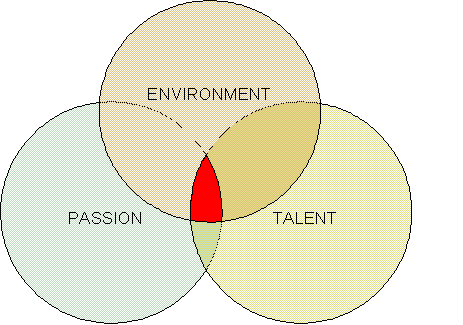In my recet post, “How to be an expert“, I talked about passion as being key to finding fulfillment in what we do. Yet so often we invest our passion into a hobby, because we can’t fully express it through our work. As hobbies rarely pay for themselves, we learn to live with spending the majority of our time doing what we think have to do in order to make ends meet, versus doing what we love to do. I don’t believe this has to be a trade-off; we can find fulfillment at work or play, once we understand the framework through which we can fully engage our creative energies to create maximum value and satisfaction.
I got the idea for the above model from Jim Collins book, Good to Great, which is one of the best books on strategy I’ve read. In it, Collins talks about great companies defining their “hedgehog”, a nexus of capability, core values and profit-generating activities. The Hedgehog concept is summarized on Collins’s website here. I’ve modified them from an organizational model of “being the best” to one of realizing personal gratification.
When I read Good to Great some years ago, I thought about how the hedgehog idea could be applied to individuals and transforming careers. By identifying the drivers of our creative potential, we can define roles that best leverage our value and contribute toward our sense of fulfillment.
The starting point is your vision of the good life. This embodies what you want to be, do and have in your future. I believe it’s important not to burden yourself with ideals, nor should you try to limit yourself in terms of thinking practically at this stage. It’s natural for your rational brain to raise all kinds of objections in this process, because it doesn’t perceive the resources available to achieve them. It also wants to keep you from taking risks, so it will turn your attention to the dangers of change and the impossibility of achieving anything radically different.
All visions begin as dreams, so don’t be too concerned with goal setting or planning; that will all come later. As you invest more thought in the ideas of what you want, you’ll begin to see greater detail, which can help you put the dream into action. If you resist defining what you want because you think it’s selfish, impractical or somehow less relevant than the needs of your family, I can only say that if you aren’t happy, it’s very difficult for the people around you to be happy.
To frame the vision of the good life, we use three circles and define fulfillment in terms of:
What am I passionate about? What is meaningful to me in terms of leaving a legacy through my work? Where could I make the biggest difference through what I do? What work do I enjoy doing for it’s own sake?
What are my talents? Where do my strengths lie? How could I apply them toward something I believe in?
What kind of environment would best reward and encourage my passion and talents? In what surroundings or culture would they be most valued? How could I be paid for them? What could I do toward creating this environment?
While I don’t like formulaic, multi-step programs that are supposed to help us “find ourself”, I believe the proven business wisdom of Good to Great, when applied to transforming individual careers, offers a clear and simple approach that can help us find new ways to deeply connect to our creative power and find new levels of fulfillment.
